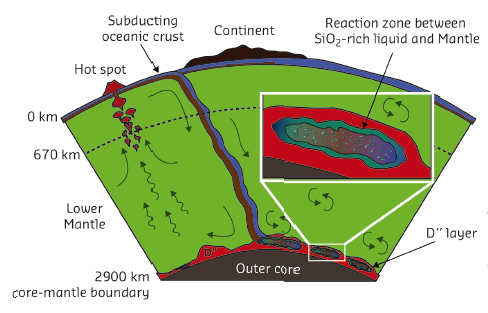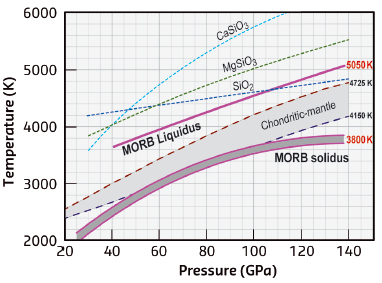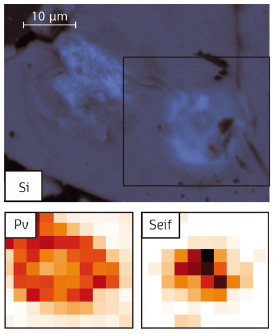- Home
- Users & Science
- Scientific Documentation
- ESRF Highlights
- ESRF Highlights 2014
- Dynamics and extreme conditions
- Melting of subducted basalt at the core-mantle boundary
Melting of subducted basalt at the core-mantle boundary
Seismological studies have demonstrated the complexity of the lowest 150-300 km-thick mantle layer, called the D” layer, situated just above the core-mantle boundary (CMB) [1] (see Figure 87). The anomalies detected could arise from various types of chemical or mineralogical heterogeneities including phase transitions in mantle minerals, chemical reactions with the outer core, presence of an ancient (crystallised) basal magma ocean and/or the deep descent of subducted slabs. Partial melting of the bulk mantle is often advocated to explain the seismic features, but it cannot explain the non-ubiquitous character of the ultra-low velocity zones (ULVZ). Partial melting would require a very hot core, higher than 4150 K [2,3], which is more than 1000 K above the mantle adiabat extrapolated to the CMB. Moreover, the hypothesis of a very hot core would be at odds with the current explanation for the existence of a geodynamo over prolonged geological periods.
 |
|
Fig. 87: Location of the D” layer, between the Earth’s core and lower mantle. |
In search of an alternative, researchers explored the melting properties of mid-oceanic ridge basalt (MORB), which can reach the lowermost mantle following subduction of oceanic crust. In the lower mantle, the MORB presents four coexisting phases: free silica, the Mg and Ca bearing silicate perovskites and a cage-type structure like calcium-ferrite. This mineralogy is radically different from the bulk mantle and, therefore, the melting properties should also be different. Due to the number of chemical elements, melting occurs progressively from the solidus, where the liquid contains a high concentration of incompatible elements, to the liquidus. The difference between solidus and liquidus can be of several 100 K at the CMB pressure of 135 GPa.
The difficulty of the experiments was therefore to determine the onset of melting using a laser heated diamond anvil cell at pressures of the CMB. The sample behaviour was followed continuously using in situ X-ray diffraction at beamline ID27. Upon heating, we observed a sequence of events: crystallisation of the high-pressure phases; continuous grain growth; and then the sudden apparition of much larger spots on the CCD detector. These spots moved quickly and eventually disappeared, and randomly reappeared, as a function of time. The fast grain rotation indicates partial melting of the sample. At a pressure of ~80 GPa (corresponding to a mantle depth of ~1900 km), the solidus temperature of ~3200 K is similar to that of the bulk mantle (Figure 88). With pressure increased to 135 GPa, the MORB solidus increases to ~3800 K, whereas that of the bulk mantle increases to ~4150 K. Thus, the onset of melting in the MORB occurs at ~350 K below the mantle solidus.
 |
|
Fig. 88: The MORB solidus and liquidus compared with melting curves of the bulk (chondritic) mantle. At the core-mantle boundary, the MORB solidus reaches 3800 (±150) K. Its curvature is much more pronounced than that of a chondritic-type mantle [2], which induces a lower melting point for the MORB at 135 GPa, the core-mantle boundary pressure. The MORB solidus also plots 1000-1500 K below the melting curves of pure SiO2 and MgSiO3, as determined from shock wave experiments. |
The flattening of the MORB solidus could be linked to a change in liquid composition with pressure. There are three indications of an increase of the SiO2 content in the liquid with pressure during partial melting of MORB. First, the MORB solidus curve always plots 1000-1500 K below the lowest melting curve for pure CaSiO3, MgSiO3 or SiO2 phases (Figure 88). Although SiO2 is the most refractory phase at low pressures, it becomes the least refractory above 60 GPa. Second, we observe the total disappearance of the SiO2 peaks above the solidus for pressures higher than 70 GPa, which indicates samples under-saturated in SiO2 compared to the liquid composition. Third, the mineralogical and chemical analyses performed on the recovered samples (Figure 89) show higher SiO2 content and presence of the high-pressure polymorph of SiO2 (seifertite), while the surrounded rim of material is composed of bridgmanite, which is the MgO-bearing phase of the MORB lithology.
 |
|
Fig. 89: Phase relations in the sample recovered after partial melting at 120 GPa. Mineralogical content (lower frames for Bridgmanite (Pv, left) and SiO2-seifertite (right)) and Si chemical map (upper frame) were measured on the recovered samples by X-ray diffraction and scanning electron microscopy. They show higher SiO2 content in the sample region corresponding to the quenched liquid. |
Following the hypothesis that the ULVZ of the lowermost mantle are associated with partial melting, our experimental results provide explanations for the seismological features. The SiO2-rich liquid that is generated by MORB partial melting could either remain trapped in the subducted slab, producing the seismic anomalies, or solidify after reaction with the surrounding Mg-bearing mantle, which would result in a remixing of the subducted basalt in the lowermost mantle.
Principal publication and authors
D. Andrault (a), G. Pesce (a), M.A. Bouhifd (a), N. Bolfan-Casanova (a), J.-M. Hénot (a) and M. Mezouar (b), Science 344, 892-895 (2014).
(a) Laboratoire Magmas et Volcans, Université Blaise Pascal, CNRS, IRD, Clermont-Ferrand (France)
(b) ESRF
References
[1] T. Lay, Q. Williams and E.J. Garnero, Nature 392, 461-468 (1998).
[2] D. Andrault, et al., Earth and Planetary Science Letters 304, 251-259 (2011).
[3] G. Fiquet, et al., Science 329, 1516-1518 (2010).



